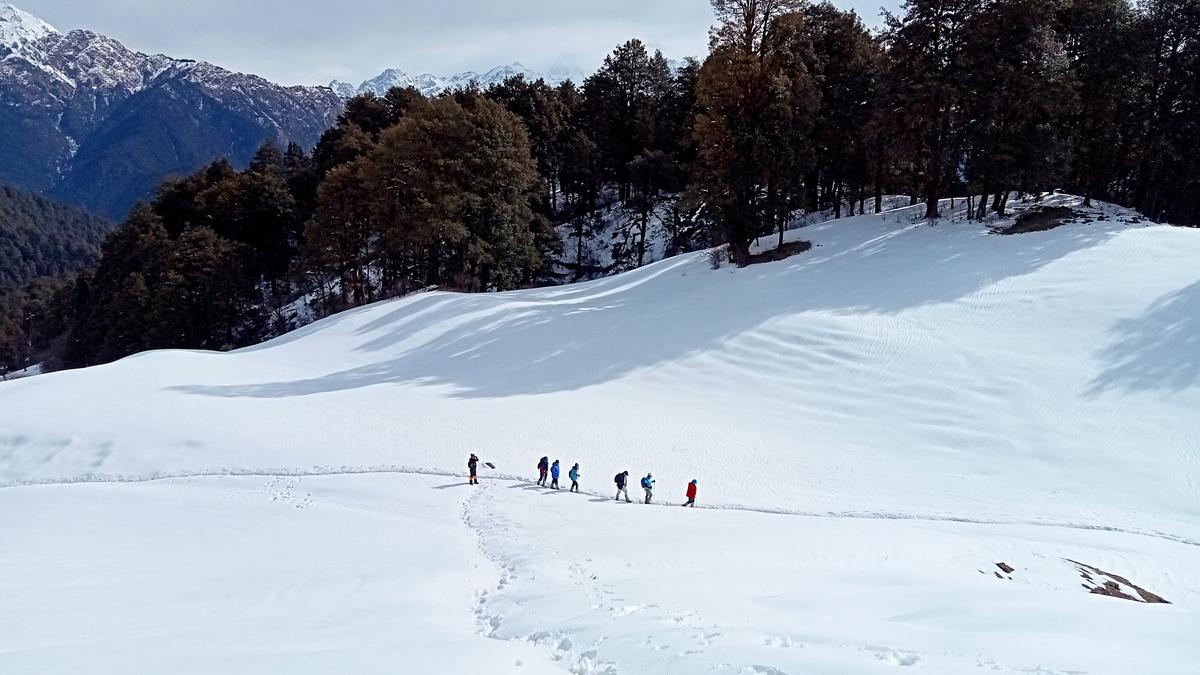
What makes winter trekking a not-to-miss experience for adventure junkies
The Hindu
As more trekkers attempt to conquer the mountains, we explore the challenges of winter treks, which demand physical fitness, good guides and considerable luck with the weather
In 2010, when Bengaluru-based Sandhya Chandrasekharayya tossed the idea of winter trekking to the locals of Sankri village in Uttarakhand’s Uttarkashi district, they were nonplussed. “No one treads this trail off season,” they remarked, pointing to Kedarkantha — a route on which they would graze their sheep and cattle in summer. Sandhya was not the sort to take no for an answer. After all, she had started her trekking organisation, Indiahikes, only a year ago. “The moment I got to know of Kedarkantha, I called out to explorers interested in a four-day winter trek to the 12,500-foot-high peak. Luckily, 18 people joined us, most of them had gone for the Roopkund trek with us that autumn. We gathered at Sankri on Christmas and started the climb the next day,” she shares.
For Sandhya, her virgin climb to Kedarkantha, in one word, would be “surreal”. “The sceneries were unlike anything we had seen. They changed with the altitude. We met snow somewhere in the middle. The next day, we started again at 4am and were probably half a kilometre from the summit when we saw sunrise. The colours were splendid. We slid down while descending and became kids again. I will never forget that experience,” she says.
Thirteen years on, Kedarkantha remains one of the most popular winter treks offered by Indiahikes. It costs upwards of ₹10,725 approximately. “Around 900 trekkers signed up for Kedarkantha trek this year,” shares Swathi Chatrapathy, chief editor of Indiahikes. While the exact number of trekking companies is hard to ascertain, Internet leads you to nearly 40 of them which offer winter trekking to over 20 destinations across the Himalayas. Thrillophilia, for instance, has listed 31 winter treks on its website. The costliest of these treks is the one to the Everest Base Camp Trek, Nepal, priced upwards of ₹46,950.
The treks are rated from easy to difficult on various parameters, ranging between duration and steepness of the climb. However, treks to peaks over 13,000 feet are not recommended during winter. Founder of Himalayan Hikers, Chain Singh Rawat, 43, from Saurgaon, Uttarkashi, suggests six treks offered by his company — Kedarkantha, Dayara Bugyal, Brahmatal, Kuari Pass, Chopta and Tungnath (Chandrshila Trek), and Nag Tibba.
Also serving as the secretary of Har ki Dhun Protection and Mountaineering Association, an organisation that undertakes trekking expeditions along with social work in the region, Chain shares, “Harsh weather is the trickiest part in winter. The temperature dips to -10 degrees Celsius at a few places, which is why North-face climbs and peaks above 12,500 feet could be dangerous.”
For mountaineering guide and skiing instructor Anurag Sood, founder of Climb The Himalayas, who has been trekking in winter since 2006, the sole motivation to climb was to carry his skiing equipment to the top and glide down. Soon, he got “hooked to trekking”. Narrating an experience, Anurag mentions the Chadar trek or Zanskar gorge trek — a 105-kilometre trail over the frozen Zanskar river in Ladakh during winter. “I did it thrice — in Feburary 2014, and January 2016 and 2017. The main reason why this 11-to-14-day trek is one of the most cumbersome is the thin ice on the frozen river. There is a risk of falling into the water, which could cause hypothermia and even death,” he says.
Because of the dangers involved, the trek is run by locals. “Not every company can offer good gear such as high-altitude tents designed for -20 to -30 degree Celsius. The other problem is experience. Newcomers are at risk on such treks. When people start getting stuck, the administration has to take charge,” says Anurag.











